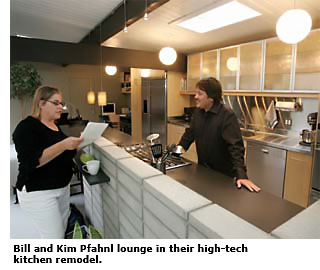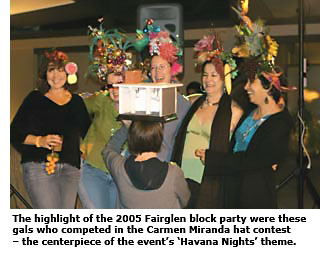Eichler Crazy in Fairglen - San Jose - Page 2
The area was still apricot and cherry orchards when Phyllis and Frank Van Wagner arrived, she remembers. Frank, who was from the East, fell in love with the Bay Area when he served in the Navy during World War II, and got IBM to transfer him to California. They loved the openness of the house, Van Wagner says, and they were impressed with Eichler's commitment to building an integrated neighborhood.
The neighborhood started out friendly, with block parties and hordes of children, 75 on their street alone, she says. "When my husband got home from work he'd drive down the block at five miles an hour."
Steve Thatcher grew up in Fairglen, left after high school, but returned, buying the family house. Other Fairglen kids do the same. "They want to hold onto that neighborhood and that feeling," he says. He remembers a neighborhood where mothers watched out for each other's children, and formed food co-ops, and where everyone knew everyone else. "It was a more communal living situation."
"It still attracts people who like to talk and get on with the neighbors," he says. "So the neighborhood still lives on in that way."
The neighborhood is still child-friendly, he says, if not as child-packed. "When we grew up," says Thatcher, who was one of five kids, "everybody had five kids. Now everybody has two." That includes Thatcher himself.
The roots of the home tour go back to the mid-1960s, when the neighborhood had its first art festival. The festival began small, with a handful of people showing their art, says Mickie Bruno, who helped run some of the festivals. Fairglen had its share of creative people, so the idea spread. "People saw it," she says, "and said 'I can do that too.'"
The festival grew in popularity. Rock and roll bands would play, folk dancers would perform in a driveway, and the late Jim Thatcher, Steve's dad, hauled in sand for a neighborhood sand castle. "It was kind of like a country fair," Bruno says. The festival got so big Sunset magazine wrote it up, and the city took notice. Officials spoke about fees, health inspections, liability. "The city required that Lloyds of London get involved," neighbor Scott Nicholls says. In 1995 the event died.
But you can't keep Fairglen down. Funds in the festival's account were turned to good use for the first neighborhood home tour in 2001.
At first, people opened their homes to show off their household collections and other hobbies, says Carmen Nicholls, Scott's wife and a member of the Fairglen Home Tour Committee. But it soon became a venue for people who wanted to show off their ho mes after remodeling.
Anyone can open their home as part of the tour, says Nagwani, who is credited by everyone as the event's prime mover. It is not necessary to be an Eichler purist. But last year's tour of five homes attracted the true fans.

Visitors admired Bill and Kim Pfahnl's high-tech kitchen remodel and enjoyed Ann and Jerry Escobar's digital before-after-and-during slide show. "We gutted this thing down to the studs to get it back to its original character," Jerry explained. "This was all purple sponge paint right here," he said about one wall.
Borsellino and wife Monika Kafka won praise for their period décor. "We weren't afraid of angles and boomerangs and amoebas, but we held the line at kitsch," Borsellino says. "No '50s for '50s sake. It's got to be architecturally significant. As much as I like pink flamingos, no pink flamingos. But I might put some in. No poodle stuff."
Borsellino, who bought his first Fairglen home in 1997, has seen significant changes in attitudes towards the homes. Back then, he says, Eichlers were selling for less than comparable non-Eichler homes a few blocks away. Authenticity was not on most buyers' minds. "Their interiors were still being whitewashed, for the most part," he says.
That, of course, has changed. Mid-century modernism has blossomed in popularity. TV shows, commercials, even the animated movie 'The Incredibles' are set in Eichlers, or Eichler-like houses, neighbor Chris Connors notes. "They're just seen as cool things," Sandra Ailio says. And they sell for more than their non-Eichler neighbors.

The change also means that Eichlers that retain their historic character sell for more than those that don't. "We told our realtor, 'Don't call us unless you find a virgin Eichler,' " says Dave Peterson.




